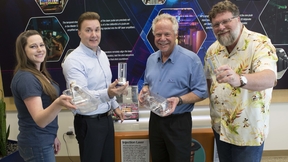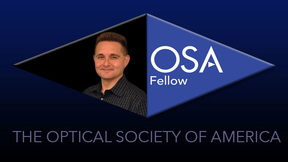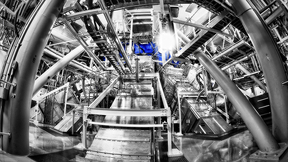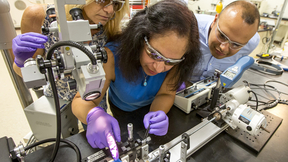Back
In a paper published today by Nature Astronomy, a team of researchers from Lawrence Livermore National Laboratory (LLNL), Princeton University, Johns Hopkins University and the University of Rochester have provided the first experimentally based mass-radius relationship for a hypothetical pure iron planet at super-Earth core conditions. This discovery can be used to…
Nearly 20 years ago, researchers conducting experiments on Lawrence Livermore National Laboratory's (LLNL) Nova Petawatt laser system -- the world’s first quadrillion-watt laser -- discovered that when the system’s intense short-pulse laser beams struck a thin foil target, an unexpected torrent of high-energy electrons and protons streamed off the back of the target…
In 2017, after more than eight years of operation, the National Ignition Facility (NIF) at Lawrence Livermore National Laboratory (LLNL) reached its epic 2,000th shot. Over that time, as the shot rate steadily climbed, other important numbers also have risen dramatically. By the end of 2017, the total number of people exposed first-hand to NIF’s world-class technology and…
Among the many discoveries on matter at high pressure that garnered him the Nobel Prize in 1946, scientist Percy Bridgman discovered five different crystalline forms of water ice, ushering in more than 100 years of research into how ice behaves under extreme conditions. One of the most intriguing properties of water is that it may become superionic when heated to several…
Henry Chapman, who worked at Lawrence Livermore National Laboratory (LLNL) from 1996 to 2007, will be presented on Jan. 26 with an honorary doctorate by Sweden's Uppsala University for his work on developing techniques for imaging and crystallography with intense X-ray pulses. In addition to lecturing as a professor of physics at Hamburg University, Chapman is the division…
Charles Orth, who has served as a physicist with Lawrence Livermore NationaI Laboratory (LLNL) for more than 40 years, was presented with the 2017 Albert Nelson Marquis Lifetime Achievement Award by the publication Marquis Who’s Who. Marquis Who’s Who is a directory of short biographies of notable figures, and the publication bestows their Lifetime Achievement Award on a…
The L3-HAPLS advanced petawatt laser system was installed last week at the ELI Beamlines Research Center in Dolní Břežany, Czech Republic. L3-HAPLS -- the world’s most advanced and highest average power, diode-pumped petawatt laser system -- was designed, developed and constructed in only three years by Lawrence Livermore National Laboratory’s (LLNL) NIF and Photon Science…
For the first time, scientists have reported in-situ diffraction experiments measuring deformation twinning at the lattice level during shock compression. The results were recently published in Nature by a team of researchers from Lawrence Livermore National Laboratory and collaborators from the University of Oxford, Los Alamos National Laboratory, the University of York…
Constantin Haefner, program director for Advanced Photon Technology (APT) at Lawrence Livermore National Laboratory, has been elected a fellow of The Optical Society of America (OSA). Haefner was recognized for "pioneering next-generation, high-average-power petawatt laser systems enabling a new arena of applications and sustained advancement of state-of-the art…
Lawrence Livermore National Laboratory (LLNL) researcher John Heebner has been elected a fellow of The Optical Society of America (OSA). Heebner was cited for his "numerous innovations, achievements and technical leadership in high-energy laser systems and integrated optics including nonlinear optical microresonators and ultrafast light deflectors." Heebner leads the…
Since its introduction in the 1977 film "Star Wars," the Death Star has remained one of science fiction’s most iconic figures. The image of Alderaan’s destruction at the hands of the Death Star’s superlaser is burned into the memory of millions of fans. Scientists and laser experts have maintained that this superbeam could never work due to the properties of lasers --…
Lawrence Livermore National Laboratory’s Félicie Albert was awarded the 2017 Edouard Fabre Prize for her contributions to the physics of laser-driven inertial confinement fusion (ICF) and laser-produced plasmas. Albert, an experimental plasma physicist at the National Ignition Facility (NIF), shares this year’s award with collaborator Alexis Casner, who is a research…
Materials scientist Xavier Lepró can’t grow his "spider webs" fast enough to swing from skyscrapers like Spiderman, but he can best another web-maker, Mother Nature, when it comes to consistency. Lepró helped pioneer the spinning of spider-silk-like yarns for use in suspending target capsules inside NIF hohlraums. These yarns are even stronger than the silks spun by the…
In an experiment designed to mimic the conditions deep inside the icy giant planets of our solar system, scientists observed "diamond rain" for the first time as it formed in high-pressure conditions. Extremely high pressure squeezes hydrogen and carbon found in the interior of these planets to form solid diamonds that sink slowly down further into the interior. The…
From sunset to sunrise, while others slumber, the "Owls" of the National Ignition Facility nurture the world’s most energetic laser through some of its most productive hours. On this particular summer night, Shot Director Steve Weaver is the Owl Shift leader of 16 scientists, engineers and technicians who keep the massive physics experiment humming, working to create…
Most of the nuclear reactions that drive the nucleosynthesis of the elements in our universe occur in very extreme stellar plasma conditions. This intense environment found in the deep interiors of stars has made it nearly impossible for scientists to perform nuclear measurements in these conditions -- until now. In a unique cross-disciplinary collaboration between the…
It all started for Mariana Lanzarini-Lopes as an undergraduate, cracking coconuts in the West Indies, seeing the effects of dysentery while working in a hospital in Africa and engineering a solar-powered refrigerator to keep medicine safe in Indian villages. This was the path that led the doctoral student in environmental engineering to join the fight to solve one of the…
Lawrence Livermore National Laboratory (LLNL) physicist Andrew MacKinnon has been awarded the John Dawson Award for Excellence in Plasma Physics Research by the American Physical Society’s Division of Plasma Physics. The annual award recognizes a specific outstanding achievement in plasma physics research. MacKinnon was cited by the APS "for pioneering use of proton…
The global spotlight was on Lawrence Livermore National Laboratory (LLNL) physicist Tammy Ma when she took the stage at the World Economic Forum’s (WEF) Annual Meeting of the New Champions, recently held in Dalian, China. The theme of this year’s meeting was "Achieving Inclusive Growth in the Fourth Industrial Revolution," and focused on collaboration in innovation,…
Along with its aesthetic function of helping create the glorious Aurora Borealis, or Northern Lights, the powerful magnetic field surrounding our planet has a fairly important practical value as well: It makes life possible. By deflecting harmful charged particles from the sun and the cosmic rays that constantly bombard the planet, and preventing the solar wind from…
























